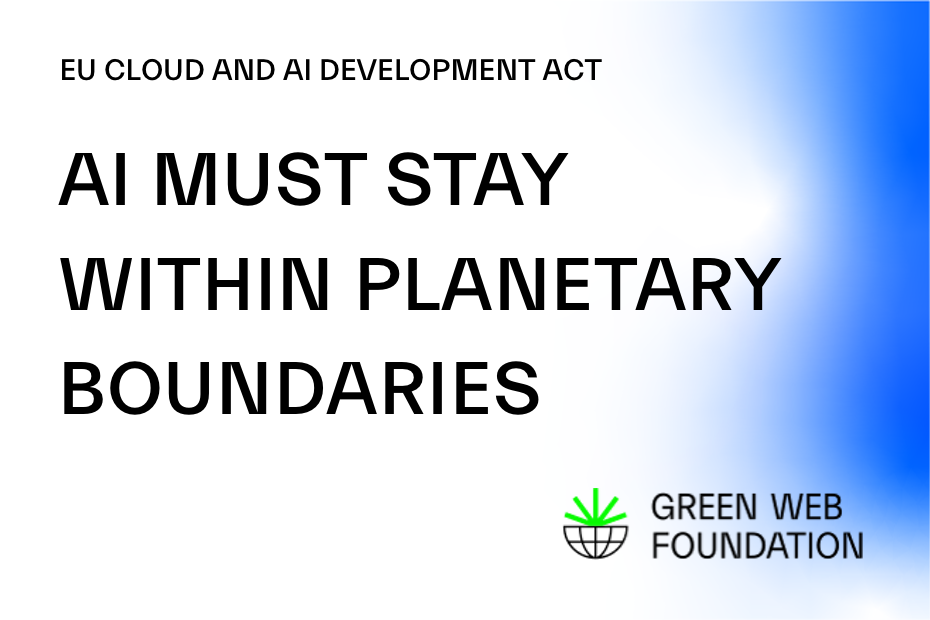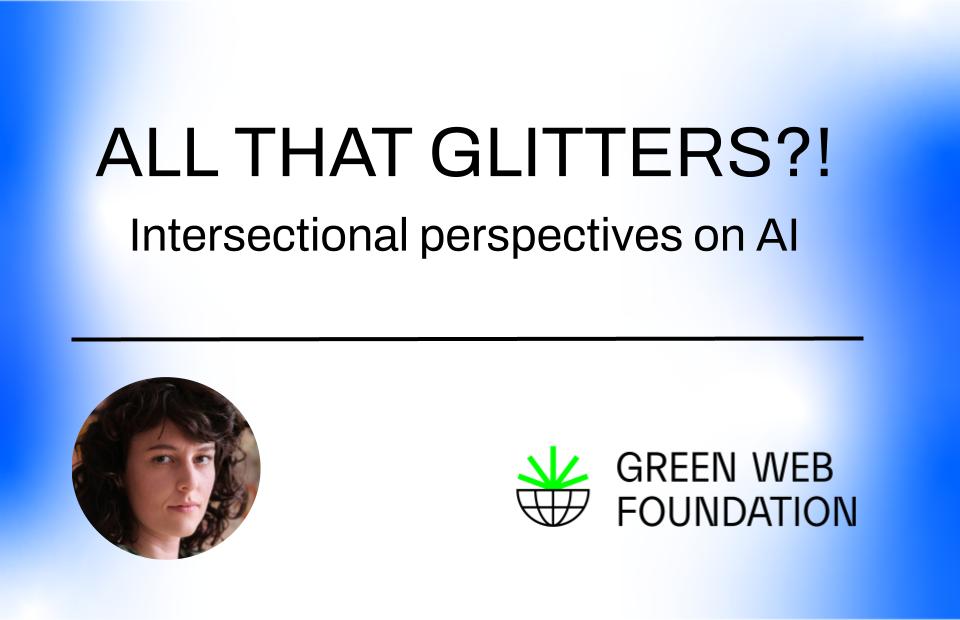In Europe, the European Commission is conducting a consultation about a new set of laws to support a significant increase in digital infrastructure being built in the region – tripling data centre capacity across Europe over the next 5-7 years. In their current form, the proposals are likely to come with a massive energy and environmental footprint, and make reaching a fossil free internet by 2030 more challenging. Our Director of Strategy, Michelle Thorne, has written a primer on why this matters, and how you can make your voice heard using our template response.
The European Commission is conducting a public consultation for the forthcoming EU Cloud and AI Development Act as part of its AI Continent Action Plan. Their current plan misses the mark on many key issues. Their public consultation is a vital opportunity to express concerns and promote demands that center planetary and social boundaries.
Together with over 20 excellent collaborators we’ve prepared a collective response to the public consultation on the Act focusing on climate and environmental concerns, while challenging the broader framing and making structural arguments. This builds on the joint statement ‘Within Bounds: Limiting AI’s environmental impact’ signed by over 150 organizations this February.
In short, this is an important moment to:
- Bring technology systems within social and planetary boundaries. How can the EU design in resource scarcity—focusing on equitable distribution of existing computation and not on overinvestment and overbuilding.
- Challenge the problematic AI strategy of the European Commission, which includes their market-first approach through deregulation, investment, and consumption.
- Challenge the framing of the question of public consultation, which is extremely industry-focussed and presupposes the need for this AI infrastructure.
- Critique the approach that only pushes for more compute. There is no question about what this computing is for or why we need all this cloud to begin with—what is the public value of all this AI investment? And for what purpose are we investing all this public and private money into AI development?
- Point out large gaps in the Act about market access. The proposed policies would not lead to “EU sovereignty” due to the cloud market concentration of a handful of American tech companies.
Saving our planet, lifting people out of poverty, advancing economic growth… these are one and the same fight. We must connect the dots between climate change, water scarcity, energy shortages, global health, food security, and women’s empowerment. Solutions to one problem must be solutions for all.
Ban Ki-moon, eighth Secretary-General of the UN, 2007 – 2016
Have your say
If you’re a concerned group or individual, we invite you to use as our templated responses and supplemental letter and send your own submission via the EU portal by July 3.
Why submitting an individual response matters
When the EU evaluates questionnaire data, it counts each response one time. So rather than one big joint submission, which would only be counted once, the goal is to have as many separate submissions as possible speaking to aligned demands.
Using the template responses
The templates are designed to be adapted, so please feel welcome to modify them for your context, expertise, and with any other arguments and resources you’d like to include. If you translate the responses, please kindly share the translation so others can use it. Responses in any of the official EU languages are welcome.
Please also feel welcome to forward these resources to other groups who may be interested in submitting a response as well. Remember, time is tight, the deadline is July 3rd.
Here is the full submission from the Green Web Foundation. Questions/comments/suggestions? Please get in touch with us.
Communicating and sharing
Please also share this in your networks and on social media to drive more responses. As mentioned above, it’s beneficial to get as many submissions as possible.
Below is a social media image you can use, also available to download from on our GDrive. Plus some copy you can use from our own LinkedIn post.
Key points
Highlights from the collective response include calling for:
1. Conduct full environmental and social impact assessments of data center sites and make them publicly available. Full impact assessments based on the entire lifecycle of a data center must be available to the public with ample time to review, in line with the EIA Directive and the Aarhus Convention.
2. Publicly disclose the projected consumption of water and energy, as well as the material footprint and waste generation. Digital infrastructure providers must be accountable for the lifecycle of their facilities, including public disclosures about the development, resource consumption, and impacts of data centres before they are built. Data center providers must also disclose information on the material footprint and waste generation in line with the European Commission’s Circular Economy Monitoring Framework.
3. Uphold climate commitments: All data centres must be fossil-free and bound to commitments to run on 100% renewable energy that is locally produced, additive to the grid, and publicly verifiable. In Europe, data centres are driving an expansion in fossil gas capacity and elsewhere, keeping coal plants open. All new computational resources must be powered by new and additional renewable energy to power new data centres. Furthermore, energy justice principles should guide the sourcing of renewable energy, so that it does not come at the cost of affordability, access, or grid stability for local communities. Furthermore, energy emission claims must reduce absolute emissions by aligning renewable energy purchases with their real-time energy use on an hourly basis. All energy claims must be publicly and independently verifiable.
4. Align computational strategy with binding targets to reduce absolute emissions in line with Europe’s 2030 climate goals. The EU set the target of reducing greenhouse gas emissions by at least 55% by 2030. The AI Continent Plan must account for reducing absolute emissions of the digital sector, which the International Energy Agency and the ITU both strongly recommended halving by 2030. The EU also has a goal of ‘achieving climate-neutral, highly energy-efficient and sustainable data centres by no later than 2030.’ The new strategy must remain in line with these commitments.
5. Update the Ecodesign for Sustainable Products Regulation (ESPR) working plan to include data centers as a “priority product”. As part of its Circular Economy Action Plan, the Commission committed to decouple growth from resource use and to keep its resource consumption within planetary boundaries. However, the Commission does not include servers and data storage products as priority products in its current working plan. This means ecodesign requirements for data centers only focus on energy efficiency, leaving out the updated requirements of ESPR around its material footprint, which constitutes its main environmental impact at the manufacturing stages.
6. Ensure meaningful participation and cost-effectiveness analysis for communities. Communities impacted by the construction and operation of computational resources must be included in any decision-making, activities and practices that affect them.The requirement of a cost-effectiveness analysis would consider values like health and saved lives without having to put these into monetary value. Participatory impact assessments and other public fora are necessary so that the people affected by AI infrastructures can fully weigh its tradeoffs and participate in decision-making.
Acknowledgements
Thank you to all the experts who contributed to and informed this response: Anastasia Tsougka (ECOS), Aurora Gómez Delgado (Tu Nube Seca Mi Rio), Alexandra Lutz, Jill McArdle (Beyond Fossil Fuels), Raegan MacDonald (Aspiration), Maya Richman (Green Screen Coalition), Michelle Thorne and Chris Adams (Green Web Foundation), Fieke Jansen (critical infrastructure lab), Emsie Erastus, Esther Mwema, Anna Colom (The Data Tank), Max Schulze (Leitmotiv), Preeti Raghunath (University of Sheffield and AI+Planetary Justice Alliance), Paulan Korenhof (Environmental Policy Department, Wageningen University), Namita Kambli (Center for Future Generations), and Sara Marcucci (AI + Planetary Justice Alliance).
Further Reading
Please see https://greenscreen.network/en/blog/within-bounds-limiting-ai-environmental-impact/




